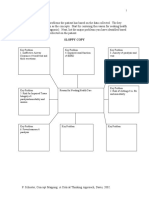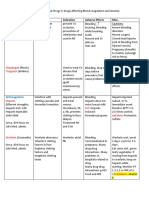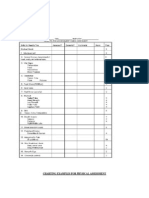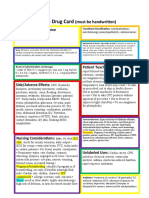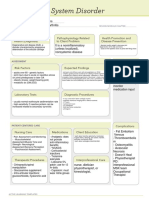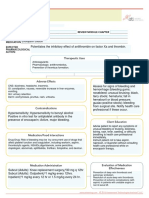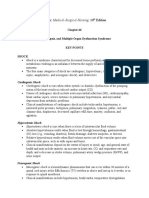System Disorder: Renal Calculi
System Disorder: Renal Calculi
Uploaded by
Holly DeckelmanCopyright:
Available Formats
System Disorder: Renal Calculi
System Disorder: Renal Calculi
Uploaded by
Holly DeckelmanOriginal Title
Copyright
Available Formats
Share this document
Did you find this document useful?
Is this content inappropriate?
Copyright:
Available Formats
System Disorder: Renal Calculi
System Disorder: Renal Calculi
Uploaded by
Holly DeckelmanCopyright:
Available Formats
ACTIVE LEARNING TEMPLATE: System Disorder
STUDENT NAME______________________________________
renal calculi
DISORDER/DISEASE PROCESS___________________________________________________________ REVIEW MODULE CHAPTER____________
Alterations in Pathophysiology Related Health Promotion and
Health (Diagnosis) to Client Problem Disease Prevention
stones made of calcium oxalate/phosphate (or other
substances) formed in the kidneys that pass into/stuck in
the urinary tract. most pass without invasive intervention,
depending on size, composition, or location
ASSESSMENT SAFETY
CONSIDERATIONS
Risk Factors Expected Findings
secondary to
high calcium diet/metabolic disorder (increased intestinal absorption/renal diaphoresis, pallor
exretion of Ca, increased intake of purines like red meat, increased oxalate
intake or production peanuts, spinach, beets)
fever medication side
pain (flank pain may indicate presence in kidney, + radiating to
renal tubular dysfunction/urinary tract lining damage
results or effects of dehydration, urinary concentration, statis,poor fluid intake,
scrotum/testes, abdomen, vulva suggests presence in ureter or bladder effects- opiates,
urinary frequency/dysuria (if in the bladder), oliguria, anuria, hematuria
retention, immobility
male gender
VS remarkable for tachypnea, tachycardia, HTN (related to pain) or NSAIDS
family hx hypotension related to shock
calculi formation prior to age 25 risk for falls, risk
for bleeding
Laboratory Tests Diagnostic Procedures
UA- ^wbc, ^rbc, + bact, + crystals (microsope), KUB or IV pyelogram (not indicated if
^pH, urine- calcium or struvite stones obstruction)
dec. pH, urine- uric acid, cystine stones CT/MRI used for detection of cystine or
altered serum levels of Ca, PO4, uric acid with uric acid (won't show on xray)
presence of metabolic disorder
renal US or cystoscopy
PATIENT-CENTERED CARE Complications
Nursing Care Medications Client Education urosepsis- occurs
increased risk for future incidence with struvite,
report finding to provider, analgesics- dietary modifications (may be based on kind of stone, but
pre/post op care if necessary, strain urine
NSAIDS, opioids,
general information). CaPO4- limit animal protein/NA/CA rich
foods. CaC2O4- limit rich foods like spinach, chard, beets,
infection may
for stones, encourage fluid intake 3L/day/IV
fluids as ordered, encourage ambulation for spasmolytics for peanuts, tea, cocoa, strawberries, pecans, chocolate, black
tea. struvite- high PO4 like red meats, dairy, whole grains. spread to
passing calculi, assess/monitor bladder spasms cystine- animal protein. uric acid- organ meats, fish, poultry,
red wine bloodstream.
pain/complications (shock) antibiotics if real lemon juice/orange juice can help break down/prevent
presence of UTI
calculi formation
obstruction,
LUT meds to hydronephrosis
promote relaxation (stone inhibits flow
Therapeutic Procedures of lower urinary tract Interprofessional Care and may distend
(tamsulosin)
extracorporeal shock wave lithotripsy- use of laser/US/shock if metabolic, may the kidney) which
wave energy to fracture calculi (req. conscious sedation and urology for involvement of
ekg) require medications may result in renal
chemolysis
to prevent/inhibit urinary tract
surgical- stent placement damage
retrograde ureteroscopy- insertion via lower tract for manual
removal reabsorption/product nutrition for education
percutaneous ureterlithotomy/nephrolithotomy- through the
skin into the ureter/kidney to remove
ion of Ca/PO4/uric regarding dietary
open surgery- staghorn, large, or impacted unsuccessful
intervention with previous methods
acid modifications
ACTIVE LEARNING TEMPLATES Therapeutic Procedure A11
You might also like
- Health Certificate For US Pet TravelDocument1 pageHealth Certificate For US Pet TravelPetRelocation.comNo ratings yet
- DNA Mutations Lab Answer KeyDocument8 pagesDNA Mutations Lab Answer KeySarah Albishah100% (2)
- Keith RN Asthma Case StudyDocument16 pagesKeith RN Asthma Case StudyCHARLES MAINANo ratings yet
- Comprehensive H&P Note Template For Phase 1 Spring Assessment 2016Document5 pagesComprehensive H&P Note Template For Phase 1 Spring Assessment 2016Derek Jones0% (1)
- NR324 RUA Case Study Presentation - Assignment Guidelines V1OLDocument8 pagesNR324 RUA Case Study Presentation - Assignment Guidelines V1OLTopGrade Achïęvers RêsęárchNo ratings yet
- System Disorder GHDDocument1 pageSystem Disorder GHDSariahNo ratings yet
- Blood Test Results: CMP Explained: Comprehensive Metabolic Panel (CMP)Document1 pageBlood Test Results: CMP Explained: Comprehensive Metabolic Panel (CMP)giuzolinNo ratings yet
- Acute PainDocument1 pageAcute Painnursing concept mapsNo ratings yet
- Concept Map HypertensionDocument1 pageConcept Map Hypertensiongeorge pearson0% (1)
- Ati Medication Template CodeineDocument1 pageAti Medication Template CodeineSharee HaywoodNo ratings yet
- Transport of Critically Ill Adults 2011Document1 pageTransport of Critically Ill Adults 2011velocity25No ratings yet
- Hypoglycemia and HyperglycemiaDocument1 pageHypoglycemia and HyperglycemiaMa Cheryll Dueñas100% (1)
- Peptic Ulcer DiseaseDocument1 pagePeptic Ulcer DiseaseEunice CortésNo ratings yet
- System Disorder ADDocument1 pageSystem Disorder ADSariahNo ratings yet
- ATI Med Template Vitamin DDocument1 pageATI Med Template Vitamin DHeather MoralesNo ratings yet
- Concept MapDocument5 pagesConcept Mapapi-546509005No ratings yet
- ElectrolytesDocument5 pagesElectrolytesChariza Trompeta100% (1)
- Cheat Sheet Acidosis and AlkalosisDocument1 pageCheat Sheet Acidosis and AlkalosisAkasha FrostmourneNo ratings yet
- DKA Concept MapDocument2 pagesDKA Concept MapJanetNo ratings yet
- Cardiovascular Drugs Chart NursingDocument2 pagesCardiovascular Drugs Chart NursingSraddha PatelNo ratings yet
- Charting Examples For Physical AssessmentDocument16 pagesCharting Examples For Physical Assessmentim3in1No ratings yet
- Electrolyte ReplacementDocument3 pagesElectrolyte ReplacementRatih Dwi OctariaNo ratings yet
- Fluids and Electrolytes ImbalancesDocument7 pagesFluids and Electrolytes Imbalancessinister17No ratings yet
- Meds - KaplanDocument3 pagesMeds - KaplanJodi BairNo ratings yet
- Electrolyte ImbalancesDocument4 pagesElectrolyte Imbalancessccctutor100% (2)
- Drug OmeprazoleDocument1 pageDrug OmeprazoleSrkocherNo ratings yet
- Waiters Rhabdomyolysis PDFDocument1 pageWaiters Rhabdomyolysis PDFTommieNo ratings yet
- IV Fluid ProtocolDocument4 pagesIV Fluid ProtocolAhmad AfghanNo ratings yet
- EndocrineDocument2 pagesEndocrineUnclePorkchopNo ratings yet
- Chapter 67 Management of Patients With Cerebrovascular DisordersDocument41 pagesChapter 67 Management of Patients With Cerebrovascular Disordersسلطان محمد فوزي سلمانNo ratings yet
- Drug CardDocument2 pagesDrug CardHannahNo ratings yet
- Ineffective Coping - Nursing Diagnosis & Care Plan - NurseslabsDocument13 pagesIneffective Coping - Nursing Diagnosis & Care Plan - NurseslabsLester MooreNo ratings yet
- Drug PrilosecDocument1 pageDrug PrilosecSrkocher100% (1)
- Clinical Template SheetsDocument6 pagesClinical Template Sheetsj.siemens1dNo ratings yet
- The Ultimate Review For MedicalDocument15 pagesThe Ultimate Review For MedicalJap Avila BernasNo ratings yet
- Head To Toe AssessmentDocument3 pagesHead To Toe Assessmentsandaman2225No ratings yet
- Clinical Medication WorksheetDocument1 pageClinical Medication WorksheetSrkocher100% (1)
- Week 13 Drug CardsDocument5 pagesWeek 13 Drug CardsPRECIOUS wardNo ratings yet
- Drug Card Week 2Document4 pagesDrug Card Week 2stacylynnschmidt8No ratings yet
- Drug Study GuideDocument3 pagesDrug Study GuideNicole CardenasNo ratings yet
- Vital Signs by Age: Age HR SBP DBP RRDocument1 pageVital Signs by Age: Age HR SBP DBP RRJe KirsteneNo ratings yet
- New Final Revision 27.10.2020Document193 pagesNew Final Revision 27.10.202098b5jc5hgtNo ratings yet
- TMendoza CriticalCareConceptMap2Document5 pagesTMendoza CriticalCareConceptMap2Theresa Fernandez Mendoza0% (1)
- Assessing Heart and Neck Vessel Heart Heart Chambers: (Tricuspid & Bicuspid)Document7 pagesAssessing Heart and Neck Vessel Heart Heart Chambers: (Tricuspid & Bicuspid)Dan Floyd FernandezNo ratings yet
- Waiters Osteoarthritis PDFDocument1 pageWaiters Osteoarthritis PDFTommieNo ratings yet
- FINAL Diabetes Medication Summary SSDocument1 pageFINAL Diabetes Medication Summary SSronique reidNo ratings yet
- Fluids Electrolytes Visual NotesDocument8 pagesFluids Electrolytes Visual NotesVin Lorenzo CampbellNo ratings yet
- Medication - ALT-Template - Enoxaparin SodiumDocument1 pageMedication - ALT-Template - Enoxaparin SodiumNancyAmissahNo ratings yet
- Pharmacology - Section 23 - Antibiotics 2Document5 pagesPharmacology - Section 23 - Antibiotics 2Pathalee ThalpavilaNo ratings yet
- Lewis: Medical-Surgical Nursing, 10 Edition: Shock, Sepsis, and Multiple Organ Dysfunction Syndrome Key Points ShockDocument5 pagesLewis: Medical-Surgical Nursing, 10 Edition: Shock, Sepsis, and Multiple Organ Dysfunction Syndrome Key Points Shockann forsyNo ratings yet
- Blood Glucose Meter PDFDocument10 pagesBlood Glucose Meter PDFsneh1509No ratings yet
- Digestive Domain Guide 1Document31 pagesDigestive Domain Guide 1surviving nursing school100% (1)
- Concept Map FinalDocument1 pageConcept Map Finalapi-383763177No ratings yet
- Potential Complications Signs and SymptomsDocument2 pagesPotential Complications Signs and SymptomsJessica GomezNo ratings yet
- Concept Map CholesectomyDocument3 pagesConcept Map CholesectomyDoreen Claire100% (1)
- ANTIBIOTICS Pharmacology NursingDocument10 pagesANTIBIOTICS Pharmacology NursingRalph Alfonse De JesusNo ratings yet
- Completed Concept MapDocument4 pagesCompleted Concept Mapapi-607361848No ratings yet
- Hypertension Ideal Care Plan - 2018Document2 pagesHypertension Ideal Care Plan - 2018DanNo ratings yet
- Sepsis Quick Reference GuideDocument1 pageSepsis Quick Reference GuideRavin DebieNo ratings yet
- The Nurse Practitioner in UrologyFrom EverandThe Nurse Practitioner in UrologyMichelle LajinessNo ratings yet
- 2324 2nd S4理 WS 3Document5 pages2324 2nd S4理 WS 3kitkitsousouNo ratings yet
- TP4Document13 pagesTP4AsdfghjlNo ratings yet
- Family Planning: Sunita Sapkota Suraj Thapa Sushma Neupane Yamjee MahatoDocument50 pagesFamily Planning: Sunita Sapkota Suraj Thapa Sushma Neupane Yamjee Mahatosuraj supremeNo ratings yet
- Applied Nursing Research: FF Dirksen, PHD, RN, Faan, Bin Suh, BSN MarkDocument6 pagesApplied Nursing Research: FF Dirksen, PHD, RN, Faan, Bin Suh, BSN MarkRyka NajibNo ratings yet
- Diapering Dressing Feeding and BabyDocument11 pagesDiapering Dressing Feeding and Babyapi-325621104No ratings yet
- G-10 Biology, 3.1 The Nervous SystemDocument10 pagesG-10 Biology, 3.1 The Nervous SystemYohannes NigussieNo ratings yet
- Veterinary Medicine and Animal Keeping in Ancient IndiaDocument11 pagesVeterinary Medicine and Animal Keeping in Ancient IndiaSwanand Raikar0% (1)
- Baile Bab 28Document45 pagesBaile Bab 28suciNo ratings yet
- Immuno Oncology Therapies White Paper PPDDocument12 pagesImmuno Oncology Therapies White Paper PPDkevalNo ratings yet
- 18 Health Tricks You Should Know About Your BodyDocument10 pages18 Health Tricks You Should Know About Your BodymarcialxNo ratings yet
- DID Atau Biasa Disebut Gangguan Identitas DisosiatifDocument15 pagesDID Atau Biasa Disebut Gangguan Identitas DisosiatifCM Studio (cikndo)No ratings yet
- HipersplenismDocument6 pagesHipersplenismDany YayanNo ratings yet
- Administration of MedicationDocument2 pagesAdministration of MedicationHayat ShiekhNo ratings yet
- Recovering Bodies Illness, Disability, and Life Writing (G. Thomas Couser)Document335 pagesRecovering Bodies Illness, Disability, and Life Writing (G. Thomas Couser)Madara SpiritNo ratings yet
- Henoch Schönlein PurpuraDocument12 pagesHenoch Schönlein PurpuraRavania Rahadian Putri100% (1)
- 12B) RenalDocument6 pages12B) RenalrbskbjzqrnNo ratings yet
- Glypressin Serbuk Injeksi 1 Mg+pelarut - Terlipressin Asetat - DKI1951700144A1 - 2019Document8 pagesGlypressin Serbuk Injeksi 1 Mg+pelarut - Terlipressin Asetat - DKI1951700144A1 - 2019edo adimastaNo ratings yet
- Checklist For Monitoring District Hospital: EmailDocument16 pagesChecklist For Monitoring District Hospital: EmailNational Child Health Resource Centre (NCHRC)No ratings yet
- 50 Sample Progress Test Q&ADocument14 pages50 Sample Progress Test Q&ADeji KajiNo ratings yet
- Vancomycin Resistant: Staphylococcus Aureus (Vrsa)Document2 pagesVancomycin Resistant: Staphylococcus Aureus (Vrsa)denaNo ratings yet
- Sexually Transmitted Infections and PregnancyDocument19 pagesSexually Transmitted Infections and PregnancyBeyins TiuNo ratings yet
- Dr. Samuel Kanyi My Health AfricaDocument1 pageDr. Samuel Kanyi My Health AfricaAbdimajid KhaliifNo ratings yet
- Spinal Cord InjuryDocument3 pagesSpinal Cord Injurybornslaw100No ratings yet
- Chronic Venous Disorders New TemplateDocument43 pagesChronic Venous Disorders New TemplateamrNo ratings yet
- Mtt27 MG FinalDocument24 pagesMtt27 MG FinalMatt GeigerNo ratings yet
- Fundamentals of Food and NutritionDocument8 pagesFundamentals of Food and NutritionMaria ZahidNo ratings yet
- PLT MeasurementsDocument6 pagesPLT MeasurementsAudreySlitNo ratings yet
- Undescended Testes (Orchidopexy)Document9 pagesUndescended Testes (Orchidopexy)nuranysha havizNo ratings yet
















